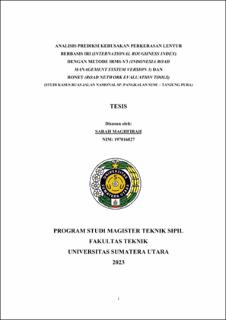Analisis Prediksi Kerusakan Perkerasan Lentur Berbasis IRI (International Roughness Index) dengan Metode IRMS-V3 (Indonesia Road Management System Version 3) dan RONET (Road Network Evaluation Tools) (Studi Kasus Ruas Jalan Nasional Sp. Pangkalan Susu – Tanjung Pura)
Prediction Analysis of Flexible Pavement Deterioration with IRI (International Roughness Index) Based for Comparison IRMS-V3 (Indonesia Road Management System Version 3) and RONET (Road Network Evaluation Tools) Method (Case Study of The National Road Sp. Pangkalan Susu – Tanjung Pura)

Date
2023Author
Maghfirah, Sarah
Advisor(s)
Anas, M Ridwan
Bangun, Emma Patricia
Metadata
Show full item recordAbstract
A Condition of flexible pavement will have a deteriorated during its service
life receiving traffic loads. To keep the pavement is fuctioning, regular
maintenance is required. However, maintenance carried out so far by the
government cannot be carried out optimally because the budgeting system is
based on the results of the back-calculation method/FWD value, where this
method can only calculate handling needs per budget year. This has an impact on
handling funding to become unsustainable. There are several methods that can be
used to predict future damage including IRMS-V3 and RONET. Both have a basis
for calculating the value of IRI as the main variable in predicting damage.
The purpose of this study is to obtain damage prediction values based
on IRI, LHR, and remaining design life using both methods. After obtaining the
damage prediction value, the most appropriate handling needs can be calculated.
The type of data used is secondary data sourced from North Sumatra BBPJN. The
analysis is carried out by calculating the IRI value, traffic volume, and the
remaining planned life for the next 5 years. Based on the results of the analysis
obtained, road damage will occur more quickly using the RONET method. Road
maintenance funds resulting from the IRMS-V3 method are more economical.
Then validated using statistical t test. The results show that there is no difference
in the average predicted IRI value, but there is a difference in the average
predicted RSL value for the two methods.
Collections
- Master Theses [278]
